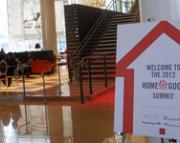Business Leaders of Los Angeles Team Up to Bring Homeless Veterans "Home for Good"
Listen to the full audio story
- 2012-02-23homeless.mp3

United Way of Greater Los Angeles has teamed up with the Los Angeles Chamber of Commerce to form Home for Good, an initiative to end chronic and veteran homelessness in Los Angeles County by 2016.
"We say it's a 5-year plan, but really it’s a change and shift in culture. We can permanently end chronic and veteran homelessness," said Jon Dusenberry of UPS.
Dusenberry is one of 21 business leaders who make up the Home for Good "task force."
Home for Good has reported "gratifying success" after its first year, having moved over 3,000 homeless people into permanent housing. However, that is merely a fraction of the city’s homeless problem.
"Los Angeles County continues to be the homeless capitol of the United States, with 51,000 people sleeping on our streets every night," said Gary Toebben, President and CEO of the Los Angeles Chamber of Commerce.
One of these 51,000, Army veteran Roy Brown, used to live out in the cold not too far from the JW Marriot downtown where the conference was held.
"If you go down 6th street, once you get on the other side of Broadway you could have found me anywhere between 4th, 5th, and 6th Street probably in a hotel or bathroom sleeping for the evening."
Home for Good believes in a "Housing First" model, which focuses on getting homeless people a roof over their head before anything else.
"You put somebody in housing before everything else," said Kerry Morrison, Executive Director of the Hollywood Property Owners Alliance. "You recognize once they have a roof over their head, then you start addressing all of their other needs, whether it's sobriety, access to benefits they might be eligible for, whether it's from the VA or Disability, but just get them under a roof."
Housing may not be the only factor, but Home for Good believes it is the most important. And for people like Roy Brown, it is this first step that makes this program so special.
"We all are human," said Brown, "and I have relapsed after going through programs. I think the concept that if you relapse you have to get kicked out of here and wait 30 days or 90 days only gave me the idea 'well let me go and use some more. Don't nobody want me. Don't nobody care about me and they're kicking me back out."
With the help of top business leaders and Home for Good, people like Ray Brown will never have to feel unwanted again. But rather, they will be greeted with open doors and a roof over their heads.
"We say it's a 5-year plan, but really it’s a change and shift in culture. We can permanently end chronic and veteran homelessness," said Jon Dusenberry of UPS.
Dusenberry is one of 21 business leaders who make up the Home for Good "task force."
Home for Good has reported "gratifying success" after its first year, having moved over 3,000 homeless people into permanent housing. However, that is merely a fraction of the city’s homeless problem.
"Los Angeles County continues to be the homeless capitol of the United States, with 51,000 people sleeping on our streets every night," said Gary Toebben, President and CEO of the Los Angeles Chamber of Commerce.
One of these 51,000, Army veteran Roy Brown, used to live out in the cold not too far from the JW Marriot downtown where the conference was held.
"If you go down 6th street, once you get on the other side of Broadway you could have found me anywhere between 4th, 5th, and 6th Street probably in a hotel or bathroom sleeping for the evening."
Home for Good believes in a "Housing First" model, which focuses on getting homeless people a roof over their head before anything else.
"You put somebody in housing before everything else," said Kerry Morrison, Executive Director of the Hollywood Property Owners Alliance. "You recognize once they have a roof over their head, then you start addressing all of their other needs, whether it's sobriety, access to benefits they might be eligible for, whether it's from the VA or Disability, but just get them under a roof."
Housing may not be the only factor, but Home for Good believes it is the most important. And for people like Roy Brown, it is this first step that makes this program so special.
"We all are human," said Brown, "and I have relapsed after going through programs. I think the concept that if you relapse you have to get kicked out of here and wait 30 days or 90 days only gave me the idea 'well let me go and use some more. Don't nobody want me. Don't nobody care about me and they're kicking me back out."
With the help of top business leaders and Home for Good, people like Ray Brown will never have to feel unwanted again. But rather, they will be greeted with open doors and a roof over their heads.
Check out the future home of Annenberg student media:

Wallis Annenberg Hall
(opening Fall 2014)

